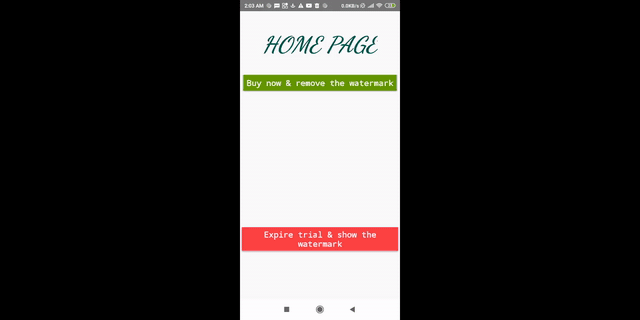Android overlay a view ontop of everything?
Can you overlay a view on top of everything in android?
In iPhone I would get the new view set its frame.origin to (0,0) and its width and height to the width and height of self.view. Adding it to self.view would then cause it to act as an overlay, covering the content behind (or if it had a transparent background then showing the view behind).
Is there a similar technique in android? I realise that the views are slightly different (there are three types (or more...) relativelayout, linearlay开发者_如何学Cout and framelayout) but is there any way to just overlay a view on top of everything indiscriminately?
Simply use RelativeLayout or FrameLayout. The last child view will overlay everything else.
Android supports a pattern which Cocoa Touch SDK doesn't: Layout management.
Layout for iPhone means to position everything absolute (besides some strech factors). Layout in android means that children will be placed in relation to eachother.
Example (second EditText will completely cover the first one):
<FrameLayout
xmlns:android="http://schemas.android.com/apk/res/android"
android:orientation="vertical"
android:layout_width="fill_parent"
android:layout_height="fill_parent"
android:id="@+id/root_view">
<EditText
android:layout_width="fill_parent"
android:id="@+id/editText1"
android:layout_height="fill_parent">
</EditText>
<EditText
android:layout_width="fill_parent"
android:id="@+id/editText2"
android:layout_height="fill_parent">
<requestFocus></requestFocus>
</EditText>
</FrameLayout>
FrameLayout is some kind of view stack. Made for special cases.
RelativeLayout is pretty powerful. You can define rules like View A has to align parent layout bottom, View B has to align A bottom to top, etc
Update based on comment
Usually you set the content with setContentView(R.layout.your_layout) in onCreate (it will inflate the layout for you). You can do that manually and call setContentView(inflatedView), there's no difference.
The view itself might be a single view (like TextView) or a complex layout hierarchy (nested layouts, since all layouts are views themselves).
After calling setContentView your activity knows what its content looks like and you can use (FrameLayout) findViewById(R.id.root_view) to retrieve any view int this hierarchy (General pattern (ClassOfTheViewWithThisId) findViewById(R.id.declared_id_of_view)).
<FrameLayout xmlns:android="http://schemas.android.com/apk/res/android"
android:id="@+id/root_view"
android:layout_width="fill_parent"
android:layout_height="fill_parent"
android:orientation="vertical" >
<LinearLayout
android:id = "@+id/Everything"
android:layout_width="match_parent"
android:layout_height="match_parent"
android:orientation="vertical" >
<!-- other actual layout stuff here EVERYTHING HERE -->
</LinearLayout>
<LinearLayout
android:id="@+id/overlay"
android:layout_width="wrap_content"
android:layout_height="wrap_content"
android:layout_gravity="right" >
</LinearLayout>
Now any view you add under LinearLayout with android:id = "@+id/overlay" will appear as overlay with gravity = right on Linear Layout with android:id="@+id/Everything"
You can use bringToFront:
View view=findViewById(R.id.btnStartGame);
view.bringToFront();
The best way is ViewOverlay , You can add any drawable as overlay to any view as its overlay since Android JellyBeanMR2(Api 18).
Add mMyDrawable to mMyView as its overlay:
mMyDrawable.setBounds(0, 0, mMyView.getMeasuredWidth(), mMyView.getMeasuredHeight())
mMyView.getOverlay().add(mMyDrawable)
I have just made a solution for it. I made a library for this to do that in a reusable way that's why you don't need to recode in your XML. Here is documentation on how to use it in Java and Kotlin. First, initialize it from an activity from where you want to show the overlay-
AppWaterMarkBuilder.doConfigure()
.setAppCompatActivity(MainActivity.this)
.setWatermarkProperty(R.layout.layout_water_mark)
.showWatermarkAfterConfig();
Then you can hide and show it from anywhere in your app -
/* For hiding the watermark*/
AppWaterMarkBuilder.hideWatermark()
/* For showing the watermark*/
AppWaterMarkBuilder.showWatermark()
Gif preview -

I have tried the awnsers before but this did not work. Now I jsut used a LinearLayout instead of a TextureView, now it is working without any problem. Hope it helps some others who have the same problem. :)
view = (LinearLayout) findViewById(R.id.view); //this is initialized in the constructor
openWindowOnButtonClick();
public void openWindowOnButtonClick()
{
view.setAlpha((float)0.5);
FloatingActionButton fb = (FloatingActionButton) findViewById(R.id.floatingActionButton);
final InputMethodManager keyboard = (InputMethodManager) getSystemService(getBaseContext().INPUT_METHOD_SERVICE);
fb.setOnClickListener(new View.OnClickListener()
{
@Override
public void onClick(View v)
{
// check if the Overlay should be visible. If this value is false, it is not shown -> show it.
if(view.getVisibility() == View.INVISIBLE)
{
view.setVisibility(View.VISIBLE);
keyboard.toggleSoftInput(InputMethodManager.SHOW_IMPLICIT, 0);
Log.d("Overlay", "Klick");
}
else if(view.getVisibility() == View.VISIBLE)
{
view.setVisibility(View.INVISIBLE);
keyboard.toggleSoftInput(0, InputMethodManager.HIDE_IMPLICIT_ONLY);
}
bringToFront() is super easy for programmatic adjustments, as stated above. I had some trouble getting that to work with button z order because of stateListAnimator. If you end up needing to programmatically adjust view overlays, and those views happen to be buttons, make sure to set stateListAnimator to null in your xml layout file. stateListAnimator is android's under-the-hood process to adjust translationZ of buttons when they are clicked, so the button that is clicked ends up visible on top. This is not always what you want... for full Z order control, do this:

 加载中,请稍侯......
加载中,请稍侯......
精彩评论